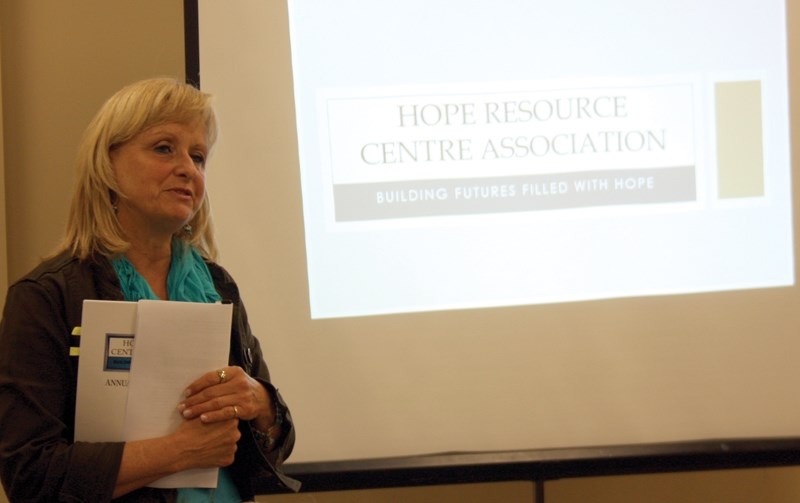About 16 people turned out to hear about the challenges and successes of the Hope Resource Centre (HRC) in Westlock at its annual general meeting last Wednesday at the Rotary Spirit Centre.
Dawn Rouncville, outgoing president of the HRC, said the centre’s new location at 1104A 107 Street is proving to be better suited to working with their clients and more financially viable. And finances are important as the centre is 100 per cent reliant on grants and donations to run its operations, she said.
Rouncville said they continue to be grateful for the community support in terms of donations and volunteer hours.
She acknowledged the difficult in acquiring provincial grants, noting many are tied to pilot projects “that typically do not allow funds to be spent on day-to-day operations.”
As well, client cases don’t end just because a particular pilot project has been completed.
To this end, the HRC was pleased with the province’s recent announcement regarding the Framework Policy to End Family Violence in Alberta.
“It is our hope that the outreach, referral services and treatment programs and education work provided at HRC will be recognized as a service essential to the health and well-being of our community and a service that deserves sustainable funding,” she said.
Rouncville said their client list continues to swell each year, likening the start of the HRC’s operations in 2009 to the opening of floodgates.
“I don’t believe that domestic violence has escalated within our community, but I do believe it’s been here all along,” she said.
“Too many victims of family violence felt that they had no choice but to live in fear and violence.”
She said victims of family violence have come to recognize the HRC as a safe and confidential place to begin putting their lives back together.
Teri Smerychynski, who has worked as a probation officer for 27 years, served as the guest speaker at the AGM.
Smerychynski said her main office is located in Westlock, but their service area includes Athabasca and Calling Lake. She works with two other probation officers and a supervisor.
Currently, their client list is just over 200 people and approximately 25 per cent of those clients are cases relating to family violence, mostly involving intimate partners. “To me that’s a pretty high statistic,” she added.
Smerychynski said the government has changed greatly in its approach to family violence, issuing a handbook in 2008 containing protocols on how to deal with family violence in the justice system.
That handbook was recently updated in 2013, which doesn’t sound like much but is actually a huge deal.
“The Criminal Code hasn’t changed for many, many years. The fact that they’re ... re-evaluating practices is really very significant,” she said.
Among the trends in sentencing family violence offenders is the addition of family violence as an aggravating factor in sentencing.
Judges weigh both mitigating and aggravating factors when sentencing an offender, Smerychynski noted. Making family violence an aggravating factor “really denounces it” she said.
With family violence, judges now say the No. 1 goal with sentencing is denunciation and deterrence. “It needs to be clearly made known to the community this is an offence,” she said.
That said, family violence is a complicated issue and victims are often in fear of their safety, so it is common for them to refuse to testify against their abusers, she said.
Therefore, Smerychynski said “peace bonds” have become increasingly common over the past five years.
A peace bond is effectively a contract with the courts to not cause any further incidents and to follow a set of conditions. It is not an admission of guilt and the person has not technically been charged.
Regardless of what sentence family violence offenders receive, Smerychynski said she finds it work best when all the entities in the system are working together — the judge, the Crown, and probation.
By the numbers
While presenting some statistics from the past year, executive director Sylvia Yoder said the HRC served 68 women and nine men over the past year.
Across all these cases, she said a total of 52 children had been exposed to family violence.
Although they deal with a large number of cases involving physical abuse, the most common form of abuse encountered by the HRC is emotional, which was a factor in more than 60 of their cases. Over 50 cases also involved psychological and verbal abuse, she noted.
Yoder acknowledged there is a misconception out there that family violence only involves “black and blue marks,” and part of their efforts is educating people on different types of abuse.
The majority of their clients were referred by other agencies, though family referrals were also very high.
She estimated the number of people reached by awareness events at around 4,163 people. She noted they do a number of events in schools and they receive strong media coverage of their activities.
Financially, the HRC finished out the year ending March 31, 2014 with a surplus of $6,460 — a dip of about $11,000 from the previous year.
Their revenue came in at $150,275, including more than $108,709 in subsidies and grants. Notably, their Dance For Hope fundraiser brought in $6,880 in 2013, while that total has nearly doubled with the 2014 event.
The HRC incurred a total of $143,815 in expenses, their largest expenses being wages and salaries and recruitment and training.

